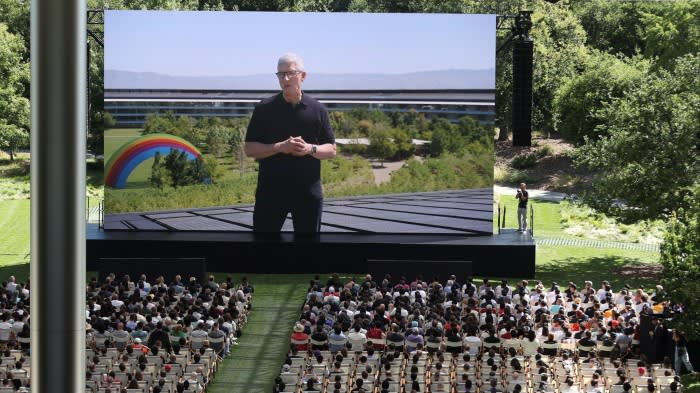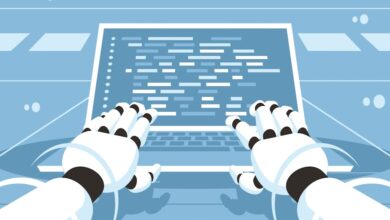iPhone maker takes control with its own AI vision

When it finally arrived, the hottest and most widely telegraphed partnership in Silicon Valley was announced so quickly that the audience at Apple’s headquarters in Cupertino barely had time to applaud it.
Anyone expecting OpenAI’s Sam Altman, one of the key players in the generative artificial intelligence fever that has swept the tech sector, to appear onstage with Tim Cook at Apple’s flagship annual developer event for an iconic photo opportunity will have been disappointed.
The focus of Apple’s event on Monday was on just that: Apple. And its message was that the partnership with OpenAI was merely the first of many.
Apple’s pitch to investors worried it is slipping behind on the technology is that if the first wave of generative AI has concerned artificial intelligence that understands the broader world, the iPhone maker is uniquely positioned to offer generative AI that understands you.
That means Apple’s own generative AI models received top billing. “Apple Intelligence” is the tech giant’s catch-all term for a suite of models, built and trained by Apple, that will be embedded in its new operating systems iOS 18, iPadOS18, and macOS Sequoia.
The company has not built generative models of the complexity and scale offered by rivals. It has opted instead to act as a gateway to other products on the market that can do the things Apple cannot. Its on-device foundational model has 3bn parameters. OpenAI’s GPT-4o and Google’s Gemini Pro are estimated to have more than a trillion.
“It doesn’t surprise me [that Apple focused on its own solutions] because they want to emphasise that they are in control,” said Gene Munster at Deepwater Asset Management. There is, he said, a “light year gap” between their model’s capabilities and OpenAI’s, and “they are not going to play that piece up”.
Neither Apple nor OpenAI would say whether the partnership involved one of them paying the other in the same way that Google pays Apple about $20bn a year to be the default search engine on the iPhone maker’s devices.
“We know that there are other models out there, and some of them have really fantastic world knowledge,” Apple senior vice-president for software Craig Federighi said following the keynote presentation. Apple, he said, is simply “starting with the best” and already has an eye on another deal with Google over Gemini.
But even if Apple is focused on its own solutions, a cultural shift is still under way, Munster said. “Apple’s AI, at the core of it, is in someone else’s hands,” he said. “They’ve never gone to a third party to license a core technology.” The company’s longtime search partnership with Google, he said, concerns a feature on the device, whereas AI “is more of an operating system”.
Apple is playing up its traditional differentiator. It says its on-device models bring privacy and security benefits, emphasising that any personal data used to train its own AI models will stay within its ecosystem. These will run as much as possible on the device. Where they do need to use the cloud, queries will go to servers owned and controlled by Apple. The idea is that users will not even notice which is being used.
The features this enables, such as custom-generated emojis, smart photo editing that allows users to seamlessly remove unwanted people or objects from photos, writing and drawing assistants, and a smarter Siri capable of more contextual awareness and interacting with both Apple’s apps and third-party apps, are incremental. The idea is that the iPhone and its productivity features will get smarter over time as the hardware gets more powerful and Apple’s own models catch up.
In the meantime, ChatGPT will be tasked with handling more complex questions sent to Siri. Those might involve, for example, sending a picture of an ingredient that OpenAI’s models can identify and recommend recipes for. It will also be integrated into Apple’s writing tools.
Users will not be forced to use the feature and will receive a prompt from Siri before doing so. OpenAI meanwhile promises “built-in” privacy protections every time Siri pings ChatGPT. Requests will not be stored — which would allow a third party to develop a profile of a user — and users’ IP addresses will be obscured. Users can choose to connect their ChatGPT account, which will mean that ChatGPT’s data policies will then apply.
The move still had Tesla chief executive and X owner Elon Musk fuming. On X, he said that Apple apparently “isn’t smart enough to make their own AI” and “has no clue” about what OpenAI would do with the data. He said he would ban Apple devices at his companies if OpenAI were integrated with them, calling it “an unacceptable security violation”.
If nothing else, Musk’s intervention reflected the intense scrutiny facing AI partnerships in Big Tech, with regulators vowing to intervene to address concentrations of power.
Meanwhile, if users want Apple’s new features, they will need to be on Apple’s latest and most powerful iPhones — the iPhone 15 Pro and Pro Max — powered by the newest A17 Pro chip. For laptops and tablets, the features will run on devices equipped with the M series of chips, which date back to 2020.
If iPhone users are clinging on to older models for longer, the demand that even smaller generative models place on ageing hardware creates an incentive for them to upgrade. The iPhone 16, expected later this year, now seems set for a heavy marketing push highlighting its generative AI features.
Francisco Jeronimo, data and analytics vice-president at the IDC research group, said the event marked “the beginning of a new era for Apple and for their users”, with Apple positioning itself to benefit from a future “supercycle” of device sales as it transitions to new “intelligent devices”.



